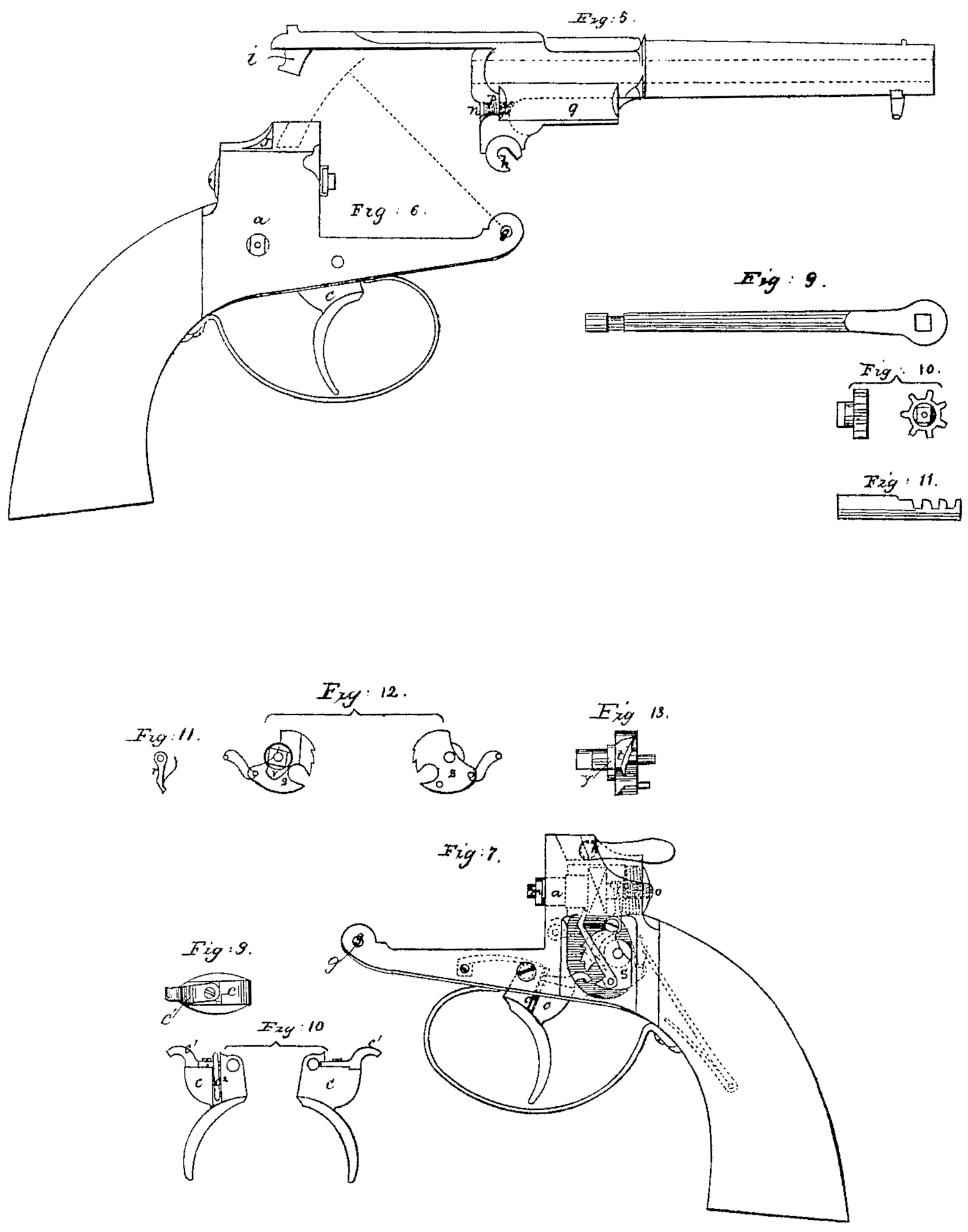US 24274
UNITED STATES PATENT OFFICE.
THOMAS BAILEY, OF NEW ORLEANS, LOUISIANA.
IMPROVEMENT IN REVOVING FIRE-ARMS.
Specification forming part of Letters Patent No. 24,274, dated June 7, 1859.
To all whom it may concern:
Be it known that I, Thomas Bailey, of the city of New Orleans, in the State of Louisiana, have invented certain Improvements in Revolving Fire – Arms; and I do hereby declare the nature of my invention and in what manner the same is to be performed is fully Set forth by the following description, reference being had to the accompanying drawings, and to the letters and figures marked thereon.
My invention of improvements in revolving fire-arms in the first place relates to that construction of the arm in which all the working and actuating revolving movements are contained inside the body thereof. For this purpose I use a tumbler the axis of which passes through the side of the body, and to which the cock is fixed in the ordinary manner and Works on the outside of the body. The ratchet for Working the revolving chamber is fixed on the pivot of the same, which pivot works through the body and is keyed to the chamber, the ratchet being worked by a lever connected to the tumbler.
My invention consists, in the second place, in having a revolving solid chamber resting on two Centers, one of which is fixed in the head of the body, so as to receive the recoil, and the other in the breech or back part of the barrel, both of which are adjustable in order to keep the revolving chamber in its true position. The nipples are inserted into the chamber parallel with its axis or line of suspension.
My invention consists, in the third place, in connecting the barrel to the body of the arm by means of a circular hook-joint, one part of which is on the under part of the body and the other on the breech or under side of the barrel, also on the top of the arm or upper side thereof by means of a circular stud or projection on the top strap of the barrel passing into a suitably-formed recess on the top or upper side or head of the body; and the barrel is fastened in its place by means of a partially-revolving key, with a spring connected there-with, being made to hold the stud firmly in the said recess.
My invention consists, in the fourth place, in stopping the revolving chamber by means of a spring-stop acting on the ratchet at right angles thereto and being moved into its required position by a cam on the tumbler.
My invention consists, in the fifth place, in cutting a notch or cavity in the cap-guard or cock-nose, so that it may rest on the solid part of the chamber and retain the latter in a safe position.
Having thus stated the nature of the said invention, I will now proceed to describe more particularly in what manner the same is to be performed.
Figure 1 of the drawings is an elevation of a pistol constructed according to my invention, and in this and all the other figures the same letters of reference indicate corresponding parts. a is the body of the pistol, in which all the revolving movements are contained, so that the cock or hammer b and the tail or handle of the trigger c and a small portion of the ratchet-pivot at its junction with the revolving chamber are the only parts of the locks which are visible on the outside thereof. The working or actuating movements for the hammer or cock and the chamber, being thus placed with-in the body of the fire-arm, are kept entirely free from dust and dirt, from the smoke or gas of the discharge, and from pieces of the exploded caps, which in other fire-arms are so detrimental to the working and injurious to the operative parts and so frequently renders them useless when extraneous matter gets in through any opening in the body.
Fig. 2 is a side elevation of the revolving chamber d detached. Fig. 3 is a front and Fig. 4 a back elevation of the same. This chamber is made solid, and is suspended on two centers, on which it revolves at e and f, one in front and the other at the back, which centers have their respective bearings in the body and the breech or back of the barrel, as hereinafter described. It will be seen that the nipples are placed parallel with the axis or line of suspension of the chamber. It will also be seen, on reference to Fig. 1, that the cock or hammer b rests on the solid part of the back of the chamber, between two of the nipples, when the cock is not in operation, a notch or cavity being formed on it for the purpose of enabling it thereby to retain the chamber in the required position of safety.
Fig. 5 represents the barrel and top strap, and Fig. 6 the body with the stock. From these figures will be understood the mode of connecting the barrel with the body of the fire-
*** Missing Page***
1. The pacing of the within named working or actuating means within the body as set forth.
2. The revolving chamber working on two adjustable centers of suspension instead of in the ordinary way.
3. The mode described of connecting the barrel to the body.
4. The stopping or retaining of the revolving chamber by means of a spring-stop acting on the ratchet, such stop being actuated by a cam on the tumbler.
5. The notch or cavity in the cap-guard or cock-nose to fit upon the solid part of the chamber and retain the chamber in a safe position
TEHOMAS BAILEY.
Witnesses:
Chas. Emerson,
J. L. Barbour.

